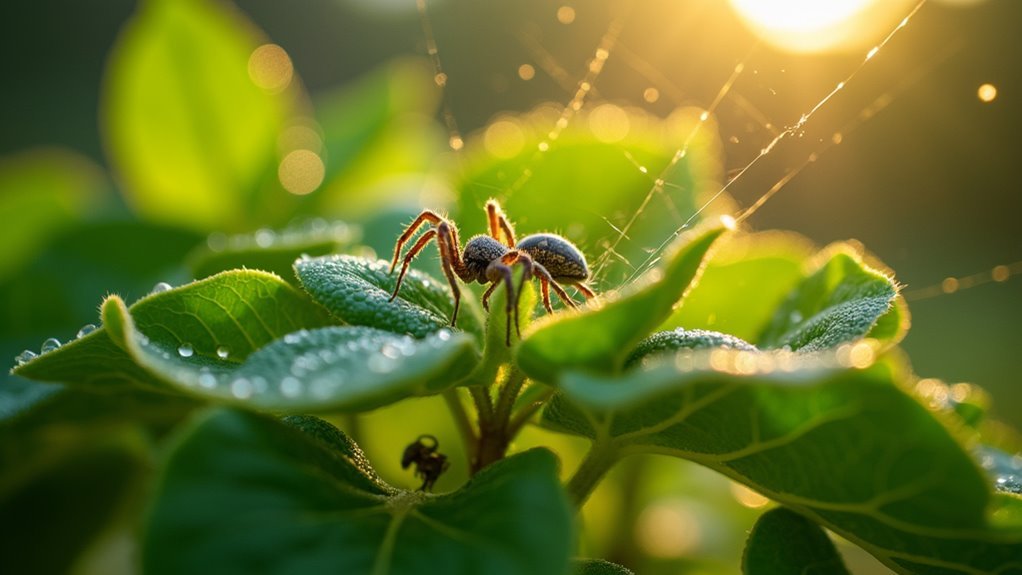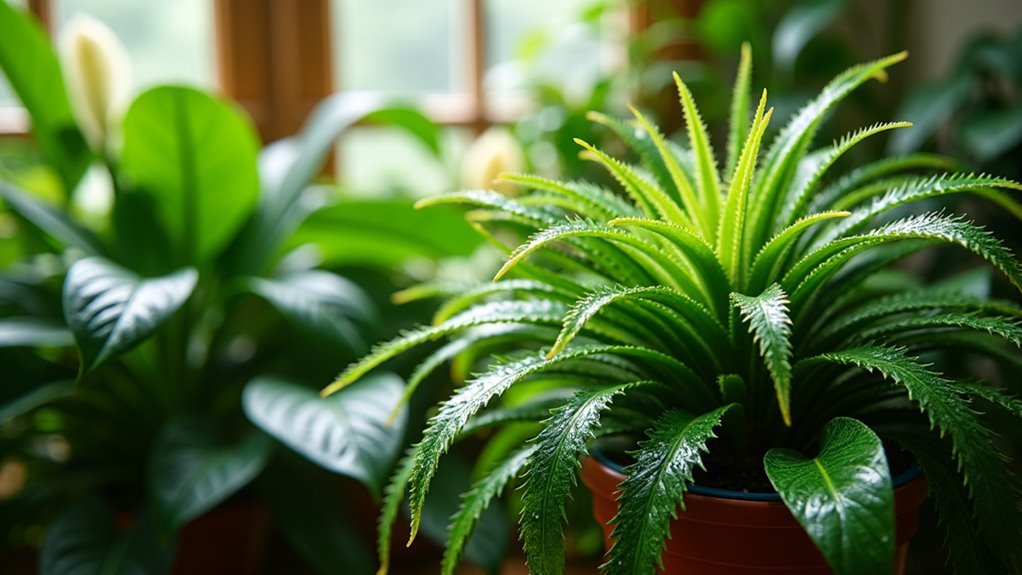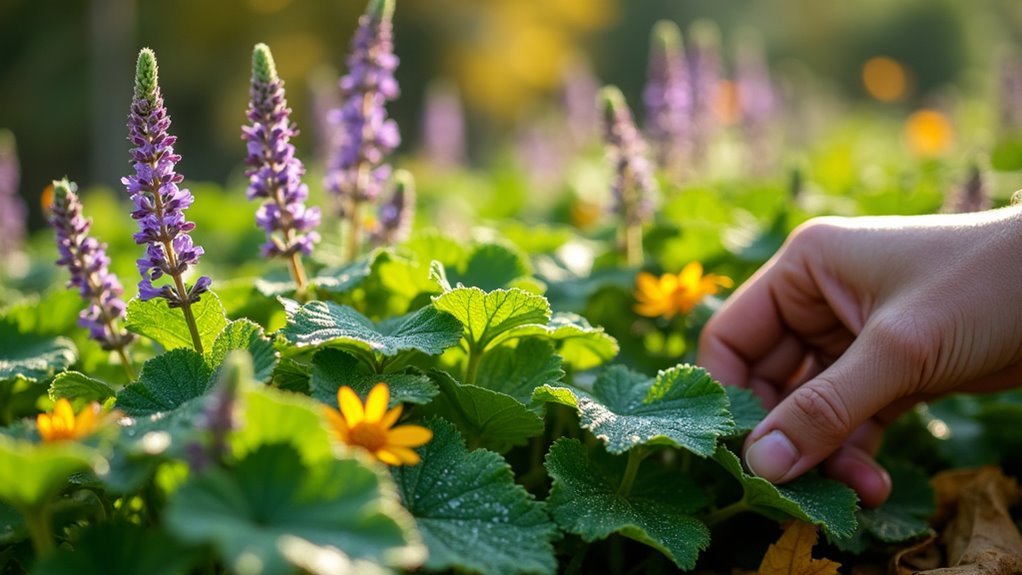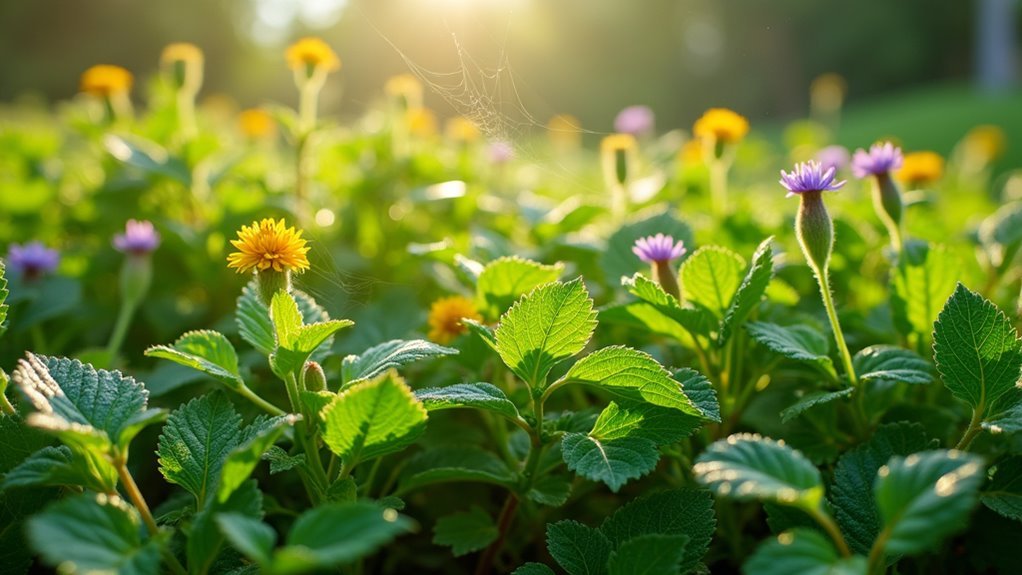Spider-repelling plants create effective barriers because they release volatile aromatic compounds that disrupt spiders’ sensory systems and navigation abilities. When you strategically place herbs like peppermint, basil, lavender, and citronella near entry points, their natural scents interfere with spiders’ ability to detect prey and find their way into your home. These plants provide continuous, chemical-free protection while enhancing your garden’s aesthetics. Discover how to maximize their protective power through proper placement and care techniques.
How Natural Scents Create Chemical Barriers Against Spiders

When you plant aromatic herbs like basil, lavender, and citronella around your home, they release volatile compounds that create an invisible shield spiders won’t cross.
These natural spider repellent plants produce terpenes and phenolics through their aromatic oils, disrupting spiders’ sensory systems and making your space uninhabitable for them.
Peppermint stands out as particularly effective at deterring spiders because its scent interferes with their ability to navigate and locate prey.
Peppermint’s powerful scent disrupts spiders’ sensory navigation systems, making it one of nature’s most effective arachnid deterrents.
When you position this strategic plant life near doorways, windows, and other entry points, you’re maximizing the concentration of these repelling compounds where they’re needed most.
The key to maintaining this chemical barrier lies in regular harvesting and maintenance, ensuring your plants continue producing the strong scents essential for keeping spiders away.
Essential Oils and Aromatic Compounds That Deter Spider Activity
You’ll find that certain essential oils pack more spider-deterring punch than others, with peppermint and eucalyptus oils containing the highest concentrations of compounds like menthol and eucalyptol that disrupt spiders’ sensory systems.
The concentration of these aromatic compounds directly impacts effectiveness—you’ll need stronger dilutions for severe infestations compared to preventive measures.
Your application method matters too, since diffusers provide continuous coverage while sprays offer targeted treatment, and each approach delivers different levels of compound saturation in your space.
Natural Compound Effectiveness
Although spiders rely heavily on their acute sensory systems to navigate and hunt, certain essential oils and aromatic compounds can effectively disrupt these abilities and drive them away from your garden or home. Spider-repelling plants produce these natural deterrents through their concentrated aromatic compounds, creating powerful barriers against unwanted arachnid visitors.
| Plant Source | Active Compound | Effectiveness Level | Additional Benefits |
|---|---|---|---|
| Chrysanthemums | Pyrethrin | High | Broad-spectrum pest control |
| Peppermint | Menthol oils | Very High | Disrupts sensory perception |
| Citronella Grass | Citronellal | High | Multi-insect repellent |
| Basil/Lavender | Essential oils | Moderate-High | Pleasant human aromatherapy |
These compounds interfere with spiders’ ability to detect prey and navigate, making treated areas inhospitable for long-term habitation.
Scent Concentration Factors
Since scent concentration determines how effectively your spider-repelling plants work, you’ll want to understand which factors influence the potency of their natural deterrents.
Different plants produce varying levels of aromatic compounds, with peppermint and citronella grass delivering the highest concentrations that spiders find most unappealing.
Basil, lavender, and rosemary also release essential oils with strong fragrances that create hostile environments for spider habitation.
You can maximize your spider-repelling plants’ effectiveness by placing them strategically near entry points where concentrated scents form protective barriers.
Regular pruning and maintenance will enhance scent concentration over time, making your natural deterrents more powerful.
The key lies in maintaining these aromatic compounds at levels that consistently discourage spider activity around your property.
Application Methods Comparison
When choosing between different application methods for spider-repelling aromatic compounds, you’ll discover that essential oil sprays and live plants offer distinct advantages for deterring spider activity.
Essential oils provide concentrated, immediate results when applied as sprays around entry points, creating powerful scent barriers that prevent spiders from establishing spider webs in treated areas. You can strategically target doorways, windowsills, and corners where spiders typically enter.
Live plants offer sustained, natural protection by continuously releasing aromatic compounds into your environment. They’re particularly effective in outdoor spaces and rooms where you want ongoing deterrent effects.
Combining both methods maximizes your spider-repelling strategy, as diffused essential oils complement the consistent aromatic presence of spider-repelling plants throughout your home.
Strategic Plant Placement for Maximum Spider Deterrence
Where you place your spider-repelling plants can make the difference between a moderately effective deterrent and a powerful natural barrier.
Strategic placement starts with positioning spider-repellent plants like lavender and basil directly near entry points such as doors and windows, where they’ll intercept spiders before they enter your home.
You’ll maximize effectiveness by grouping aromatic plants together.
Combining mint and rosemary creates stronger scent barriers that spiders find overwhelming.
For deterring spiders around your entire property, establish a diverse perimeter planting that reduces spider populations before they reach your house.
Consider using containers for aggressive spreaders like mint, allowing precise placement near entryways without unwanted garden takeover.
Remember that well-maintained plants receiving adequate sunlight produce stronger scents, making your natural spider defense system even more powerful.
Indoor Spider-Repelling Plants for Year-Round Protection

You’ll want to select indoor spider-repelling plants that can thrive in your home’s lighting conditions while effectively deterring spiders with their natural fragrances.
The best varieties include basil, rosemary, peppermint, and catnip, each offering unique benefits and requiring specific care considerations for ideal growth.
Proper maintenance of these plants guarantees they’ll continue repelling spiders throughout the year while adding fresh scents to your living space.
Best Indoor Varieties
While outdoor spider-repelling plants offer seasonal protection, indoor varieties provide year-round defense against unwanted arachnid visitors in your home.
These plants that repel spiders work through their natural aromatic compounds, creating an invisible barrier that spiders find unpleasant. You’ll find these varieties easy to maintain while they help keep your living spaces comfortable and pest-free.
The most effective indoor spider-repelling options include:
- Basil – Strong-scented culinary herb that thrives in containers and doubles as cooking ingredient
- Rosemary – Requires bright light but offers powerful aromatic spider deterrence alongside kitchen utility
- Mint varieties – Peppermint works exceptionally well; grow in pots to control aggressive spreading
- Sage – Maintains potent scent without fertilization, making it low-maintenance yet highly effective
Care and Maintenance
Successful spider deterrence depends on keeping your indoor plants healthy and aromatic. Your herbs need 6-8 hours of daily sunlight to maintain their spider-repelling properties. Regular pruning encourages healthy growth while enhancing the strong scents essential for deterring spiders effectively.
Monitor your plants consistently for pests and diseases, as stressed plants lose their repellent capabilities. Container gardening works best for aggressive spreaders like mint, allowing you to control their growth indoors while maintaining their effectiveness.
Avoid over-fertilizing your spider-repelling herbs. Too much fertilizer weakens their natural aromas, reducing their ability to deter unwanted arachnids.
Focus on proper care and maintenance routines that preserve these plants’ natural defensive properties, ensuring year-round protection against spider intrusions in your indoor spaces.
Outdoor Landscaping Plants That Create Natural Boundaries
Strategic placement of spider-repelling plants around your property’s perimeter transforms your landscaping into a powerful natural defense system.
These aromatic barriers create an effective method for keeping spiders away while enhancing your outdoor aesthetic. You’ll establish multiple layers of spider control through thoughtful plant selection and positioning.
Consider these powerful outdoor landscaping options:
- Lavender, basil, and rosemary – Plant these around entry points where their strong scents deter spider activity most effectively.
- Chrysanthemums – Position strategically to repel spiders while attracting beneficial insects that improve your garden’s ecosystem.
- Citronella grass – Incorporate into landscaping for dual protection against both spiders and mosquitoes.
- Mint and lemon balm – Place in garden beds to limit spider access while providing aromatic benefits.
Seasonal Effectiveness and Plant Care Considerations

As temperatures fluctuate throughout the year, your spider-repelling plants’ effectiveness will vary considerably based on their growth cycles and aromatic intensity.
During warmer months, these plants produce their strongest scents while actively growing, maximizing their barrier potential. However, seasonal effectiveness requires strategic plant care considerations to maintain year-round protection.
You’ll need to bring indoor varieties like basil, rosemary, and mint inside during winter, providing adequate light and adjusting watering schedules.
Perennial spider-repelling plants such as lavender and lemon balm must be overwintered indoors in cooler climates to survive for next season’s use.
Regular pruning enhances growth and scent production, strengthening their repelling properties.
Don’t forget to monitor for pests and diseases throughout all seasons, ensuring your natural spider barriers remain healthy and effective.
Pet Safety When Using Spider-Repellent Plants
While spider-repelling plants offer natural pest control benefits, they can pose serious health risks to your beloved pets.
Many effective options like lavender, citronella, basil, and mint present toxicity concerns when ingested by dogs or cats.
Understanding pet safety protocols is essential when incorporating spider-repellent plants into your home.
Consider these safety measures:
- Research plant toxicity thoroughly before selecting spider-repellent varieties for your space.
- Place plants in elevated containers or areas completely inaccessible to curious pets.
- Educate household members about dangerous varieties like lemon verbena and chrysanthemum.
- Conduct regular garden inspections to identify signs of pet interaction with potentially harmful plants.
Implementing these precautions allows you to enjoy spider-repellent plants while protecting your pets from accidental poisoning.
Combining Multiple Plant Varieties for Enhanced Protection
Beyond relying on a single plant species, you’ll achieve superior spider control by combining multiple repellent varieties throughout your outdoor spaces.
Maximize your natural spider defense by strategically combining multiple repellent plant varieties instead of depending on just one species.
When you strategically place spider-repelling plants like basil, lavender, citronella, peppermint, and rosemary together, their strong scents complement each other and create a diverse aromatic barrier that’s more effective than individual plantings.
This multi-plant approach offers several advantages. You’ll maintain year-round protection by mixing perennials and annuals that thrive in different seasons.
The combined scent strength increases deterrent power while creating complex habitats that support beneficial insects. Focus your efforts around doorways and windows where you’ll maximize protective benefits.
This natural barrier won’t just repel spiders effectively—it’ll also enhance your outdoor space’s visual appeal while providing consistent, functionally superior protection.
Plant Maintenance Tips to Preserve Repelling Properties
To keep your spider-repelling plants working effectively, you’ll need to maintain their health through proper watering and sunlight exposure.
Each plant variety has specific requirements – mint thrives in partial shade with consistent moisture, while lavender prefers full sun and well-draining soil.
Regular pruning is equally important since it encourages new growth and strengthens the aromatic oils that actually repel spiders.
Watering and Sunlight Needs
Proper care of your spider-repelling plants directly impacts their effectiveness, as stressed or unhealthy plants produce weaker scents that won’t deter spiders effectively.
Your spider-repelling plants need specific watering and sunlight conditions to maintain their protective properties. Meeting these requirements guarantees they’ll continue producing the strong aromatic compounds that keep spiders away.
Essential care requirements include:
- Sunlight exposure: Provide 6-8 hours of direct sunlight daily, with full sun preferred for herbs like rosemary and sage.
- Watering frequency: Water regularly but adjust for your climate conditions to prevent root rot from overwatering.
- Soil moisture monitoring: Check soil before watering to avoid both drought stress and waterlogged conditions.
- Seasonal adjustments: Modify watering schedules based on temperature and humidity changes throughout the year.
Pruning for Scent Strength
When you maintain your spider-repelling plants through strategic pruning, you’ll greatly boost their aromatic strength and defensive capabilities.
Regular pruning during the growing season encourages bushier growth while enhancing the aromatic oils that effectively deter spiders. You should remove dead or overgrown foliage to concentrate the plant’s scent-producing abilities.
Harvest leaves regularly from herbs like basil and rosemary to stimulate fresh growth and reinforce natural aromas. This practice keeps your spider-repelling barriers at peak effectiveness.
However, avoid fertilizing plants such as sage and mint, as this weakens their natural scent properties. Focus on strategic cutting rather than feeding to maintain potent aromatic oils that spiders naturally avoid.
Climate and Hardiness Zone Requirements for Optimal Growth
Understanding your local USDA Hardiness Zone is essential for selecting spider-repelling plants that’ll thrive in your specific climate conditions.
Matching plants to your hardiness zone guarantees they receive adequate sunlight and moisture, enhancing their growth and natural repellent properties.
Consider these climate-specific recommendations:
- Zones 3-11: Mint adapts well across diverse climates, making it versatile for most regions.
- Zones 5-8: Lavender thrives in moderate winter temperatures and temperate conditions.
- Zones 10-12: Basil, rosemary, and citronella grass flourish in warmer climates year-round.
- Indoor cultivation: Cold-sensitive plants like basil and lemon balm can become perennials when grown indoors in colder climates.
You’ll maximize your spider-repelling plants’ effectiveness by choosing varieties suited to your specific hardiness zone and climate requirements.
Scientific Evidence Behind Plant-Based Spider Deterrents
While many gardeners rely on plant-based spider deterrents through tradition and observation, scientific research increasingly validates these natural repellent methods.
Studies demonstrate that spider-repellent plants like basil and lavender release volatile organic compounds that disrupt spiders’ ability to locate food and shelter. When you use essential oils from peppermint and citronella, you’re employing active compounds that interfere with spiders’ sensory receptors, deterring them from treated areas.
Aromatic herbs such as rosemary and sage produce scents that spiders find unpleasant, effectively reducing their presence.
Chrysanthemums contain pyrethrins that repel spiders while acting as natural insecticides, limiting their food sources. By integrating these plants into your landscaping, you’ll create an ecological barrier that reduces spider populations.
Frequently Asked Questions
Does Spider Barrier Spray Work?
Spider barrier spray does work temporarily by disrupting spiders’ sensory perception and creating protective perimeters around your home. However, you’ll need regular reapplication since weather conditions reduce its effectiveness over time.
What Is a Spider Barrier?
A spider barrier is a preventive measure you’ll use to keep spiders away from specific areas. You can create these barriers using chemical sprays, physical blocks, or natural deterrents like aromatic plants around your home’s entry points.
Do Spider Plants Keep Spiders Away?
You shouldn’t rely on spider plants to keep spiders away. Despite their name, they don’t repel spiders effectively. You’ll get better results using strong-scented plants like basil or mint for natural spider deterrent.
What Is the Most Effective Spider Repellent?
You’ll find peppermint most effective since it’s got the strongest aroma among spider-repelling plants. You can also use chrysanthemums with pyrethrin or group multiple repellent plants together for maximum deterrent power.
In Summary
You’ll find that spider-repelling plants offer a natural, chemical-free solution that’s both effective and environmentally friendly. By strategically placing varieties like lavender, mint, and citrus plants around your home’s perimeter and indoors, you’re creating multiple layers of aromatic protection. Remember to maintain these plants properly and choose species suited to your climate zone. With consistent care and the right plant combinations, you’ll establish a reliable barrier that keeps spiders away year-round.





Leave a Reply